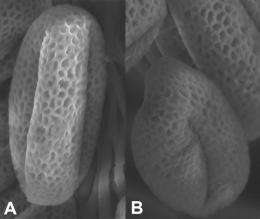CSI at the service of cellulose synthesis

(PhysOrg.com) -- Grains, vegetables and fruit taste delicious and are important sources of energy. However, humans cannot digest the main component of plants - the cellulose in the cell wall. Even in ruminants, animals that can metabolise cellulose, the digestibility of the cell wall plays a crucial role in feed utilisation. Scientists are therefore looking for ways of increasing the digestibility of animal feed, and of utilising plant cell walls to generate energy. To do this they must first understand how plant cells develop their cell walls from cellulose and identify the genes and proteins involved.
Scientists at the Max Planck Institute of Molecular Plant Physiology in Potsdam, working in collaboration with colleagues from the USA, have now discovered a hitherto unknown protein required for cellulose production. (PNAS, July 1, 2010, prepublished online)
Unlike animal cells, plant cells have a cell wall made of various sugar polymers, the main component of which is cellulose. This gives the plant its stability, protects it against pathogens and is involved in seed germination and fruit maturity. Cellulose accounts for between 35% and 50% of the dry weight of plants, making it the most common biopolymer on earth.
Cellulose is synthesized directly at the plasma membrane by a protein complex. Up to now, cellulose synthase (CESA) was the only known component of this complex. This enzyme arises in plant cells in different forms that vary in structure. Genetic studies indicate that three of these forms, CESA1, CESA3 and CESA6, are required for the synthesis of the primary cell wall, while CESA4, CESA7 and CESA8 are necessary for the synthesis of the secondary cell wall. The primary cell wall forms during cell growth and is particularly flexible and ductile. In contrast, the secondary cell wall forms when the cell is fully grown and is thicker and more rigid than the primary cell wall.
It was not previously known how many forms of CESA exist in the protein complex and whether it contains other proteins. Scientists working with Staffan Persson at the Max Planck Institute of Molecular Plant Physiology and their colleagues in the USA have now identified the Cellulose Synthase-Interactive Protein - CSI1 - which is involved in cellulose synthesis. CSI1 appears to be associated with the CESA complex as it interacts with the cellulose synthases of the primary cell wall (CESA1, 3 and 6). The researchers succeeded in demonstrating that the protein plays an important role in the formation of cellulose. "Plants that cannot form any CSI1 due to a mutation demonstrably produce less cellulose. They have short and swollen roots, and their pollen grains collapse," explains Dr. Staffan Persson.
The scientists have yet to discover the precise role played by CSI1 in cellulose synthesis. They suspect that the protein influences the speed of cellulose production and the spatial orientation of the individual cellulose fibrils. The researchers would thus now like to examine the precise role of CSI1. The insights gained from these more detailed studies will contribute to a better understanding of the biosynthesis of cell walls. This knowledge could increase the chances of achieving better cell wall digestibility in animal feed, and enable the utilisation of cell walls to generate energy.
More information: Ying Gu, Nick Kaplinsky, Martin Bringmann, Alex Cobb, Andrew Carroll, Arun Sampathkumar, Tobias I. Baskin, Staffan Persson und Chris R. Somerville, Identification of a cellulose synthase-associated protein required for cellulose biosynthesis, PNAS, July 1, 2010, prepublished online (doi: 10.1073/pnas.1007092107)
Provided by Max-Planck-Gesellschaft

















